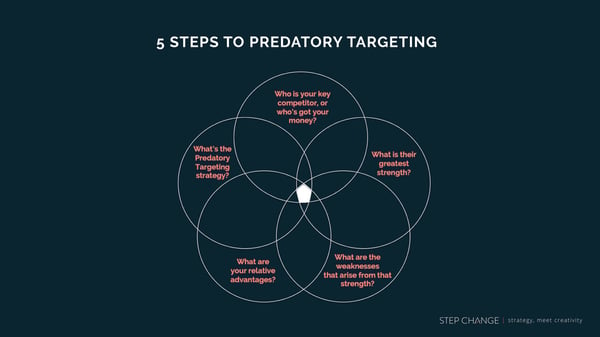There are many ways and combinations for targeting strategies. In this video, our Founding Partner talks about the most powerful one — a framework for thinking like a predator.
Insight: Many businesses today lack focus. In trying to gain the upper hand, they try to do everything all at once, which is bad for business.
Data: CB Insights report that 19% of businesses fail because of losing out to the competition while 13% fail because of a lack of focus.
Key Action Point: Learn how to use Predatory Targeting to strike at your competitor’s greatest strength and create a strategy that drives results.
Editor’s note: This is an edited transcript of the video presentation, which was filmed in Sales ITV’s Growth Conference.
There are many ways to target, and there are multiple ways to do it. There are very complex models out there, but today, we’ll highlight the simplest and the best that we’ve found over the last ten years.
It is how to think like a predator, and it will force us to shift our focus because everyone is too broad. I promise you that when I show you how targeted we got with a client, you will be scared you wouldn’t be able to sell with that level of targeting, but of course, I’ll prove that it does drive business results.
What Is Predatory Targeting?
Predatory Targeting is striking at the weakness that arises from your competitor’s greatest strength.
Though it sounds like striking at your competitor’s weakness, it’s not. And trust me, that’s a really bad idea. If you have a strong competitor with a certain weakness and you strike at it, it will just thump you.
Predatory Targeting is a simple framework that allows you to create a targeting strategy that achieves a couple of things:
It creates a clear purchase decision in your prospect’s mind.
Predatory Targeting is strategic because we are forcing a reposition of the competition. I know you probably want these category values, but you’ll want to do something they don’t do, so it forces them out of mind and gives you a clear purchase decision in the customer’s mind.
It forces you to focus on your relative advantages as a business.
By this, we mean looking into what we do better than anyone else and zero in on that. The number one issue in targeting is that people target too broadly. Focusing on what you do better achieves maximum impact for you as a strategy. But it also does something very special — it makes response from the competitor most difficult.
Why? Because if you’re striking at their greatest strength, they’re not going to change their strategy. That has been working for them, and they’re going to stick to their guns because they’re human just like everyone else. With Predatory Targeting, not only do you get a strategy that works, you also get one that has longevity.
Case Study: How Predatory Targeting Transformed the Rufus Partnership
Simon owned a business called the Rufus Partnership. There’s a reason I picked this example specifically. It is a one-person solo printer business, and I like it because if this strategy can work for a solo printing business, with limited money and time, then it can work for everyone.
Simon had a couple of problems: He wanted to increase his revenue. He wanted to reduce the number of meetings that were absolutely wasting his time. He wanted to have his conversion rate. And he wanted to build value in the business beyond himself.
Another big problem was that as a brand, Rufus Partnership didn’t mean anything for its clients. Now if you ask yourself about your brand and your prospects, when they [your prospects] look into your communications, do they know what you’re doing and why it’s different than everybody else?
Simon was dealing with other 200,000 professional services businesses in the country, and he was competing for the same dollars. In fact, what his clients and target market does is they decide on their change initiatives, they work at how much money they’re willing to spend, and then go to market and choose the three to five things they’re doing differently that year. So even a corporate adviser like Simon sometimes comes up against the dollars that I might fight for. And that was what he was dealing with.
Many of us have similar problems like Simon. In fact, every salesperson has something they need to work on. It’s an endless pursuit where nature, by design, will reduce us to merely survive, when deep down we’ll want to thrive. So for one sales professional to another, it’s good to pick a target.
We have listed down our top 10 of the most common outcomes that we’re looking to achieve with an optimised targeting strategy.
- People are always pushing the price down or not seeing the true value of the offering.
- I don’t know why some leads convert and others don’t. I can’t identify the good ones.
- I need to increase my margins.
- Not enough to convert, whether they be leads, proposals, or quotes. This is the one that upsets me the most.
- Clients use other people for problems that we could solve. And we run into this every day. We’re still working on this.
- It takes too long for my proposals to convert.
- Quotes and proposals take too long to write.
- There’s too much competition from others.
- I’m not loving selling.
- I feel like people don’t really know what I want.
What is your number 1 problem? How do you think can you solve it?
Predatory Targeting in Action

Predatory Targeting is how we solved Simon’s problems. It’s really simple. There are five questions you need to answer.
- Who is your key competitor? Who’s got your money? This is probably a competitor, but as we’ve seen, this might also be an adjacent category.
- What’s their greatest strength?
- What is the weakness that comes out of that strength?
- What are your relative advantages?
- What’s the Predatory Targeting strategy?
Now let’s get back to Simon.
Who are his key competitors?
Simon’s competitors are the 200,000 at the top (or every one of the X of professional service firms in Australia).
What is their greatest strength?
Big professional service firms do everything because scale allows them to hold multiple markets. And the small ones, like Simon, focus on consultative sales and will do whatever they can sell, which is really great for the customer but terrible for profitability.
What is the weakness that arises from this strength?
Although they are using different strategies, they have the same issue: they try to be everything to everyone, often with no clear targeting or compelling story.
What was the relative advantage?
Simon may have taken a while to pull it out, but he had a particular skill that very few other people had. He was the CFO at the helm of two very large private New Zealand businesses, and he manages them through a sale through and an earn-out. Now he does a lot of stuff, if you look at his service list. He’s a talented man, but the one thing that he loves doing most, that does best, and where his credentials are in and where he makes the most margin is the earn-out.
When we look at what this business enjoyed doing most, did best, for whom and had the best credentials in, it also happened to be where they made the most margin. And the track record was unbelievable!
What’s the Predatory Targeting strategy?
When we piled it all together, we found that he didn’t have to stop selling those services; he didn’t have to give away any of his clients. What he needed to do is make his marketing work harder so the onboarding is faster. By focusing on the owners of SME-sized and predominantly family businesses, we created a message in a way that forced them to self-select under the need-state “I’m ready to start my earn-out now”.
We then asked them one very difficult question, a question that keeps many business owners up at night: “What is my business worth today?” Because we spend so much time building value into it, we thought it might be worth all that time.
The result
We took the Rufus Partnership and transformed it into the Start Your Earn-Out Now — a clear call to action and a new brand.
So how targeted have we really gotten there? There are 1.7 million businesses in Australia that are active. He saw the choices that we went through, and we ended up with just targeting 12,000 CEOs in Australia. Now anyone that is good in math knows that is 0.0006 % of the previous targeting.
But it really enables a couple of things. That marketing plan only had three things in it:
- A five-step process and some IP to manage the clients through an earn-out
- A video-driven website
- A very targeted speaking tour with the presentation materials to talk through those CEOs
The magic is in what’s no longer in there: it has created clarity in the business and, therefore, better efficiency in the funnel.
- Leads turn out knowing what they want
- There was clarity in his marketing results
- The meetings are more qualified — a lot of his early-stage meetings closed verbally and they haven’t even written a proposal yet because he turns up with a set play rather than with a blank sheet, asking for a consult, and having a proposal ready in three days. He turns up with a system.
- He has more time to focus on revenue-generating activities
- He went from a world that was very competitive to being a clear specialist.
- Instead of having proposals that are tailored and complex, he doesn’t need to tailor them as much anymore and they still convert a lot.
So that’s a good world for a salesperson, and it’s a better sales life. The results speak for themselves.
- 400% increase in mandates, and you can read revenue there because they are highly correlated
- Conversion time has been halved
- We got a 500% return in marketing and sales, and now he’s known as the Start Your Earn-Out guy.
And this means that when someone goes to see him, it’s because they’ve been told a really great story and they know exactly how to refer.














